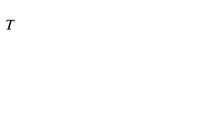Abstract
A 0-1 matrix is d-disjunct if no column is covered by the union of any d other columns. A 0-1 matrix is (d; z)-disjunct if for any column C and any d other columns, there exist at least z rows such that each of them has value 1 at column C and value 0 at all the other d columns. Let t(d, n) and t(d, n; z) denote the minimum number of rows required by a d-disjunct matrix and a (d; z)-disjunct matrix with n columns, respectively. We give a very short proof for the currently best upper bound on t(d, n). We also generalize our method to obtain a new upper bound on t(d, n; z).
Similar content being viewed by others
References
Alon N., Spencer J.H.: The Probabilistic Method. Wiley, New York (1992)
Balding, D.J., Bruno, W.J., Knill, E., Torney, D.C.: A comparative survey of non-adaptive pooling designs. In: Genetic Mapping and DNA Sequencing, pp. 133–154. Springer, New York (1996)
Bruno W.J., Balding D.J., Knill E., Bruce D.C., Doggett N.A., Sawhill W.W., Stallings R.L., Whittaker C.C., Torney D.C.: Efficient pooling designs for library screening. Genomics 26, 21–30 (1995)
Du, D.Z., Hwang, F.K.: Pooling Designs and Nonadaptive Group Testing: Important Tools for DNA Sequencing. World Scientific, Singapore (2006)
Du D.Z., Hwang F.K., Wu W., Znati T.: New construction for transversal design. J. Comput. Biol. 13, 990–995 (2006)
D’yachkov A.G., Macula A.J., Rykov V.V.: New constructions of superimposed codes. IEEE Trans. Inform. Theory 46, 284–290 (2000)
D’yachkov A.G., Rykov V.V.: Bounds of the length of disjunct codes. Problems Control Inform. Theory 11, 7–13 (1982)
D’yachkov A.G., Rykov V.V., Rashad A.M.: Superimposed distance codes. Problems Control Inform. Theory 18, 237–250 (1989)
Erdös P., Frankl P., Füredi Z.: Families of finite sets in which no set is covered by the union of r others. Israel J. Math. 51, 79–89 (1985)
Füredi Z.: On r-cover-free families. J. Comb. Theory Ser. A 73, 172–173 (1996)
Hwang F.K., Sós V.T.: Non-adaptive hypergeometric group testing. Studia Scient. Math. Hungarica. 22, 257–263 (1987)
Kautz W.H., Singleton R.C.: Nonrandom binary superimposed codes. IEEE Trans. Inform. Theory 10, 363–377 (1964)
Macula A.J.: Error-correcting nonadaptive group testing with d e-disjunct matrices. Discrete Appl. Math. 80, 217–222 (1997)
Ngo, H.Q., Du, D.Z.: A survey on combinatorial group testing algorithms with applications to DNA library screening. DIMACS: Series in Discrete Mathematics and Theoretical Computer Science, vol. 55, pp. 171–182. American Mathematical Society, Providence (2000)
Ruszinkó M.: On the upper bound of the size of the r-cover-free families. J. Comb. Theory Ser. A 66, 302–310 (1994)
Wolf J.K.: Born again group testing: multiaccess communications. IEEE Trans. Inform. Theory IT-31, 185–191 (1998)
Author information
Authors and Affiliations
Corresponding author
Additional information
The work of Y. Cheng and G. Lin is supported by Natural Science and Engineering Research Council (NSERC) of Canada, and the Alberta Ingenuity Center for Machine Learning (AICML) at the University of Alberta.
The work of D.-Z. Du is partially supported by National Science Foundation under grant No.CCF0621829.
Rights and permissions
About this article
Cite this article
Cheng, Y., Du, DZ. & Lin, G. On the upper bounds of the minimum number of rows of disjunct matrices. Optim Lett 3, 297–302 (2009). https://doi.org/10.1007/s11590-008-0109-2
Received:
Accepted:
Published:
Issue Date:
DOI: https://doi.org/10.1007/s11590-008-0109-2




